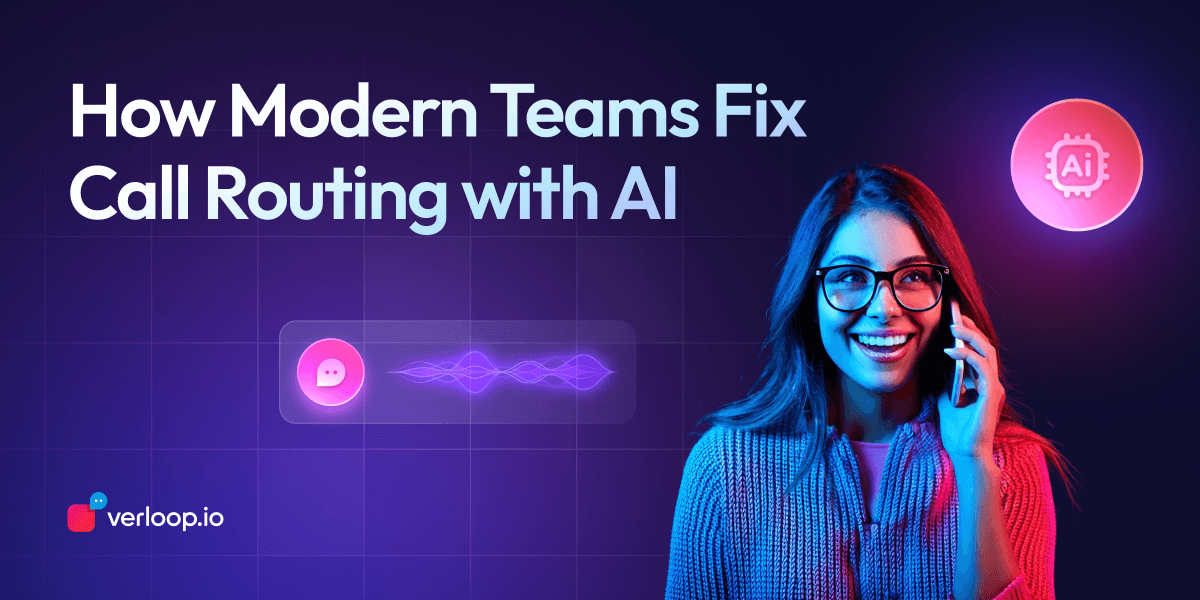
AI Call Routing Explained – How Intelligent Routing Improves Customer Support
- April 28th, 2025 / 5 Mins read
- Harshitha Raja
Every minute matters in a support team’s day.
When you’re handling hundreds of inquiries, even small inefficiencies compound. The routing delays, the repeated “Let me transfer you” scenarios, the context lost between agents it all adds up.
This isn’t a one-off story. It’s the daily reality for all support teams juggling growing volumes, demanding SLAs, and frustrated customers.
And it usually boils down to one thing. Bad call routing.
Now here’s the kicker: your call routing itself isn’t the problem. It’s how you’ve been doing it.
That’s where AI Call Routing steps in.
Studies show that AI-driven routing and classification save teams 1.2 hours of productivity per agent, per day. That’s not some marginal difference. That’s in fact a full shift regained per week.
Furthermore, according to a research by Neilson Norman Group, support agents using AI handle 13.8% more customer inquiries per hour.
Now that’s the power of AI call routing for you.
In this blog, we’ll break down what AI call routing really means, how it works under the hood, where it outperforms traditional systems and the real-world impact it’s already making for modern support teams.
What Is AI Call Routing and Why Should Support Teams Care?
AI call routing is the use of machine learning and natural language understanding to automatically direct incoming support calls to the most suitable agent or team based on context, intent, historical data, and routing logic.
Unlike traditional systems that rely on static rules or fixed IVR flows, AI-powered routing systems make dynamic decisions in real time. They evaluate a range of inputs from customer history and issue type to language preference and even sentiment. Upon evaluation, they connect the right customer with the right agent.
However, this doesn’t just mean routing to human agents.
According to various reports, 60 – 80% of incoming support queries account for repetitive queries. In cases such as these, AI-powered call routing systems involve voice AI agents to resolve common queries without human involvement.
AI call routing helps determine whether a customer should speak to a voicebot, a human, or both and when to make that switch.
AI call routing is often also referred to as intelligent customer routing or automated intelligent call routing.
So, what does having an AI-powered call routing system in place mean for support teams?
For support teams, this means:
- Fewer transfers
- Shorter resolution times
- Happier customers
- And agents who aren’t stuck handling issues that are either repetitive or outside their scope
AI call routing provides a smarter, data-driven way to handle high volumes while keeping the quality of conversations intact.
In other words, it’s how modern support teams are making routing less reactive and more intentional.
How AI Call Routing Actually Works Without Sounding Like Sci-Fi?
At its core, AI call routing is powered by a decision engine that learns, adapts, and routes in real time. But let’s break that down a little.
The process ideally starts when a customer reaches out either via phone, web, or app. Behind the scenes, the AI begins analysing everything it already knows. This includes past tickets, customer profile data, issue history, language preferences, and any prior conversations across all the channels.
As the next step, natural language understanding (NLU) kicks in. The system processes the customer’s input, whether spoken or typed, to detect the intent.
Is this about billing, technical support or a high-priority account renewal?
For example, when your customer says, “Hey, I got charged twice,” AI knows it’s billing and would route the call to the respective department.
Whereas if the system identifies the query as simple and repetitive like checking order status, updating contact info, or resetting a password, the AI decides to route it to a voice AI agent instead of a human. These agents can handle conversations end-to-end in a human-like manner using advanced features such as speech recognition, speech normalisation, call disposition, etc.
Another important use case, if the system detects confusion, urgency, or negative sentiment, it instantly reroutes the call to a qualified human agent skipping the voicebot entirely.
This fluid routing between AI and human touchpoints is what makes modern call flows feel seamless, reduces response times exponentially and maintains CSATs.
To sum up, AI-powered call intelligence evaluates:
- The context of the query
- Customer type (new, VIP, churn risk, etc.)
- Sentiment and urgency
- Historical resolution patterns
Based on this evaluation, AI instantly determines the most relevant agent or team, not just based on availability, but also capability and relevance.
And over time, the system gets better. It learns from successful resolutions, failed transfers and agent feedback making automated intelligent call routing becomes more accurate and aligned with your business outcomes.
AI Call Routing vs Traditional Call Routing
You’re probably thinking about the previous system that had already been in place for years. The one built on fixed rules, static IVRs, and linear flows that sort of worked.
That’s traditional call routing.
It assigns calls based on rigid conditions: “if X, then send to Y.” They had simple logic, hard-coded flows, and very little flexibility.
It made sense when your volumes were predictable, issues were straightforward, and customer expectations weren’t sky-high.
But here’s what happens today:
- Customers reach out with layered, context-heavy issues.
- They expect quick, relevant responses.
- And your support teams end up dealing with more pressure than ever.
Traditional routing wasn’t built for this. It’s reactive, doesn’t learn and doesn’t know how to personalise. And any complex issue raised either means more manual effort, or worse, a frustrated customer.
AI call routing, on the other hand, is adaptive. It learns from every call. It uses real time customer intent and does not just function using keywords. It evaluates your customer’s full context and not just the current query that’s been raised.
Here’s a quick contrast:
Traditional Call Routing | AI Call Routing |
Fixed rules | Dynamic decision-making |
IVR menus | Contextual intent recognition |
No learning mechanism | Self-improving with every interaction |
One-size-fits-all flows | Personalised routing per customer |
Reactive adjustments | Predictive, real-time optimisation |
Summing up, while traditional systems just route calls based on rigid conditions, AI routing understands them first.
Benefits of Using Intelligent Call Routing in 2025
The best way to understand what AI call routing changes? Look at where it actually fits and what it fixes in day-to-day support workflows.
Here’s what intelligent call routing really unlocks for modern support teams:
Faster resolutions, fewer escalations
Since AI call routing is done based on issue type, past history, agent capability and various other factors, there’s a drastic reduction in back-and-forth. This means quicker fixes, fewer call transfers, and more satisfied customers.
Seamless collaboration between voice AI agents and human agents
AI call routing can route calls to or away from voice AI agents, depending on context. This ensures customers get AI-powered service when it’s helpful, and a real person when it matters most.
For example, in an e-commerce setup, a voice AI agent handles order tracking queries and return status checks. But if the customer expresses frustration or asks for a refund, the system routes the call mid-conversation to the respective department’s agent. The handoff is instant, and the context is carried over too to enable the agent to resolve the customer’s query instantly with the necessary information.
Happier agents who do the work they’re best at
As we’d mentioned earlier, AI-driven routing and classification save teams 1.2 hours of productivity per agent, per day. AI routing eliminates the repetitive queries reaching the agents and draining their time. Agents now only get queries they’re equipped to solve and avoid the ones that drain productivity.
Deloitte suggests that companies using AI are 35% less likely to face situations where agents feel overwhelmed.
Scalable operations, minus the chaos
Fintech support teams usually see a 3x spike in queries during tax or payment dates. Traditional routing would’ve overloaded your frontline agents. But with AI call routing, calls are load-balanced based on queue size, agent bandwidth and urgency without manual intervention.
Whether it’s 50 calls or 5,000, AI call routing handles spikes without breaking workflows. It adapts in real time, unlike static systems that need constant reconfiguration.
Real-time learning with zero manual intervention
With automated intelligent call routing, every interaction improves the next one. The system learns from resolutions, failed transfers, and customer feedback and updates routing logic without your team lifting a finger.
Personalised support without increasing headcount
Imagine a travel platform using AI to recognise returning customers with pending claims. Instead of sending them through the same generic flow, AI would now connect them to a claims resolution agent who handled their last call. This way, the context is preserved, customer experience is elevated and no extra staff is needed.
By combining AI powered call intelligence with customer context, you can offer tailored experiences at scale without needing a bigger team to do it.
Matching by language, region, or even tone of voice
As a business, your goal is to offer great support to every customer no matter where they’re from or what language they speak.
With natural language detection, AI call routing can identify a customer’s preferred language or regional cues, and either connect them to agents who understand them best culturally and linguistically or let your multilingual voice AI agent handle the call.
However, this eliminates the awkward transfers and ensures the “lost-in-translation moments”.
These are some of the everyday wins support teams are already seeing with automated intelligent call routing and it’s changing how they handle volume, complexity, and scale.
How to Pick the Right AI Call Routing Software Without Regrets?
Based on everything we’ve seen so far, it’s clear that not all call routing softwares are built the same.
While choosing a solution for your business, what actually matters is how seamlessly the system fits your workflow and how much it lets you get out of the way while it does its job.
Here’s a quick checklist that will help you to choose the right AI call routing software for your team:
✔️It should route calls based on real-time intent and context, and not just availability
✔️ It should support intelligent routing between voice AI agents and human agents with seamless context switching
✔️It must integrate seamlessly with your CRM, ticketing systems, etc.
✔️It should keep learning and evolving with every customer interaction
✔️It must handle multiple languages, customer types, and routing layers without breaking flow
✔️It should be customisable. You should be able to tweak something without needing your dev team’s help every time.
✔️It must scale with your team, whether that’s 5 agents or 500
Now, if you’re wondering who’s already checking all these boxes, that’s where Verloop.io comes in.
Verloop.io’s Gen AI-powered platform brings together an extensive suite of features such as intelligent call routing, context-aware automation, intelligent conversational voice AI agents etc., all built together to help you deliver delightful customer experiences at scale, without overwhelming your agents or overhauling your existing tools.
Suggested Reading: Read how Verloop.io’s Voice AI Works in detail here
Let your Routing Think
AI call routing isn’t just a feature. It’s the foundation for faster, smarter, and more personalised support.
By combining real-time context, intelligent decision making, and continuous learning, it connects each customer to the right resolution path without wasted steps or repeated information. It simplifies agent workflows, scales with your team, and keeps the quality of support high even as volumes grow.
That’s the quiet power of AI call routing. It’s not just about faster. It’s about better.
See how Verloop.io makes AI call routing effortless.
Schedule a demo today.
FAQs
1. What Are AI Calls?
AI calls refer to customer interactions handled or assisted by artificial intelligence, often using Voice AI agents or automated systems. These calls can identify intent, personalise the experience, and route or resolve queries without human involvement. AI calls are now key in reducing hold times, improving self-service, and freeing agents to focus on more complex customer issues.
2. What Is Automated Intelligent Call Routing and How Does It Work?
Automated intelligent call routing uses AI to instantly direct calls based on data like intent, history, and customer type. It’s not just faster, it’s smarter. The system learns from outcomes and dynamically adapts its routing logic, ensuring better call placement without needing constant manual updates. It’s how modern support teams optimise agent efficiency and customer satisfaction.
3. How Does Call Routing Software Improve Customer Experience?
Call routing software helps streamline support operations by sending each call to the most relevant person or system. A smart call router doesn’t just assign based on availability. It understands the context and urgency. This means fewer transfers, faster resolutions, and a smoother experience for the customer from the very first hello.
4. Why Is Intelligent Customer Routing Important for Modern Support Teams?
Intelligent customer routing brings relevance into the equation. Instead of relying on static rules, it uses real-time insights to decide who should handle a query. For support teams juggling volume, language diversity, and priority customers, this means less chaos, better workload distribution, and more first-touch resolutions without the pressure of constant micromanagement.
5. Can AI Call Routing Replace Human Agents Entirely?
No, and it shouldn’t. AI call routing enhances support, not replaces it. It works alongside agents to handle repetitive tasks, make smart routing choices, and escalate when needed. The goal isn’t full automation. It’s better collaboration between bots and humans. That’s what makes AI routing a core part of future-ready support operations.






